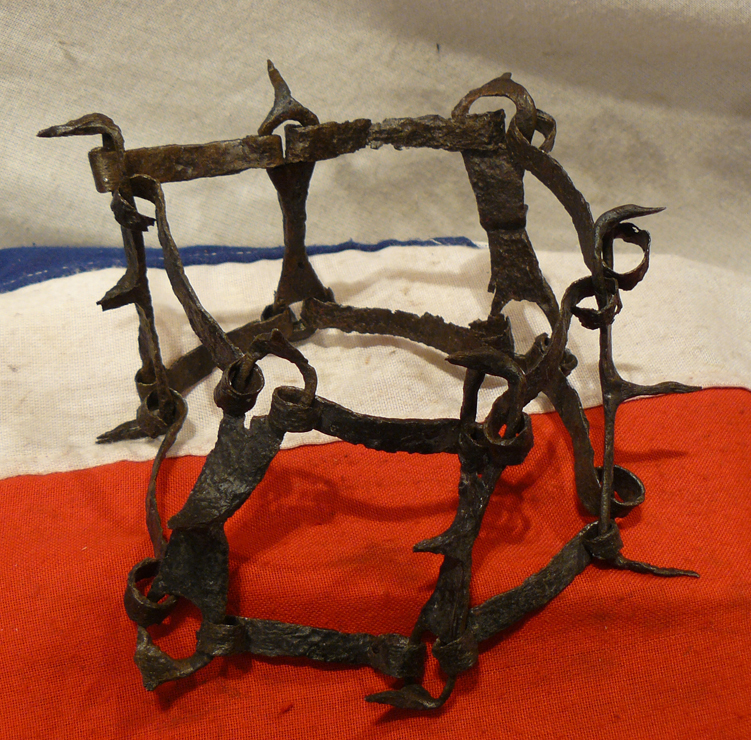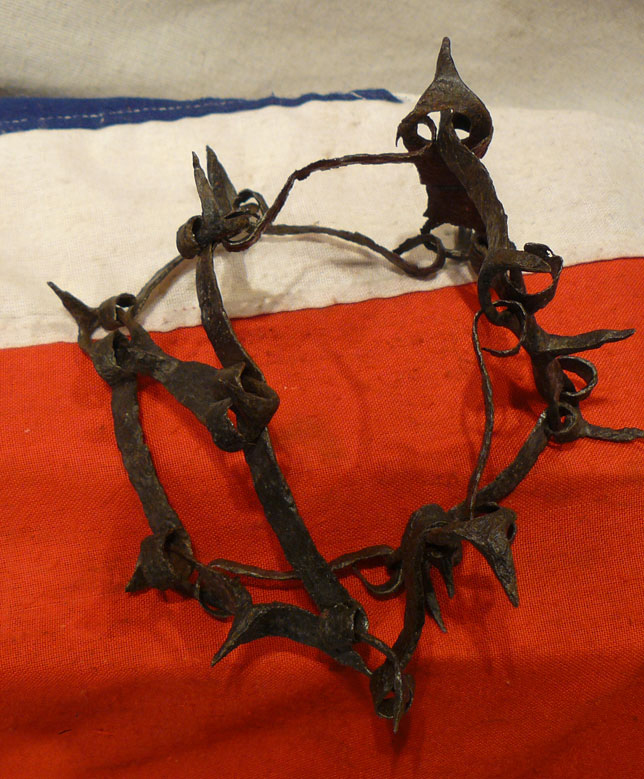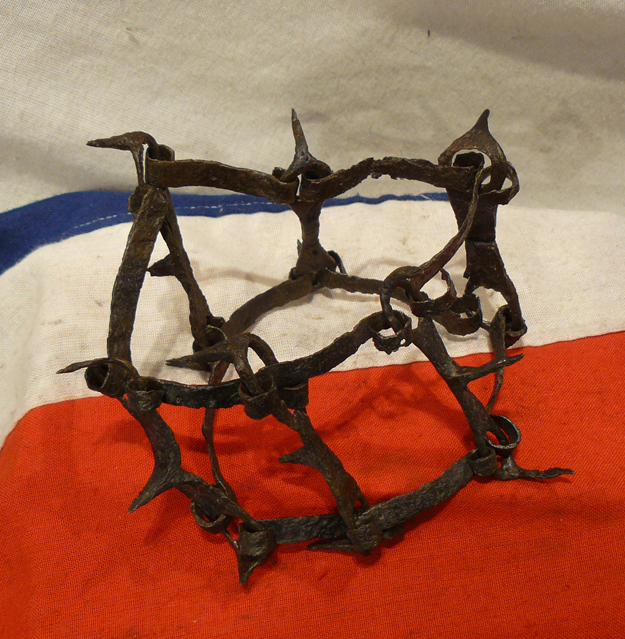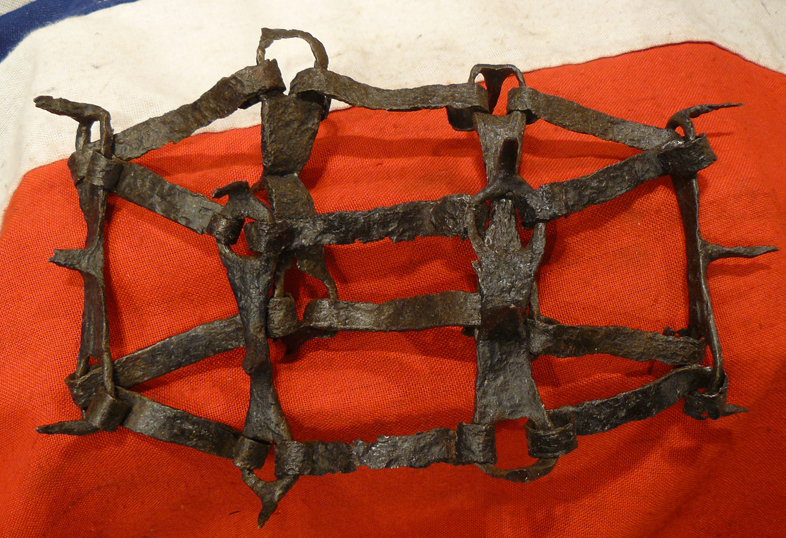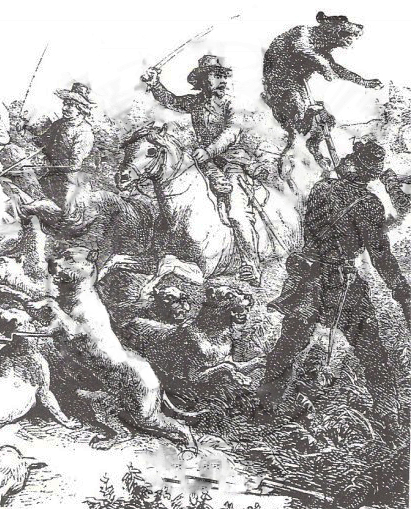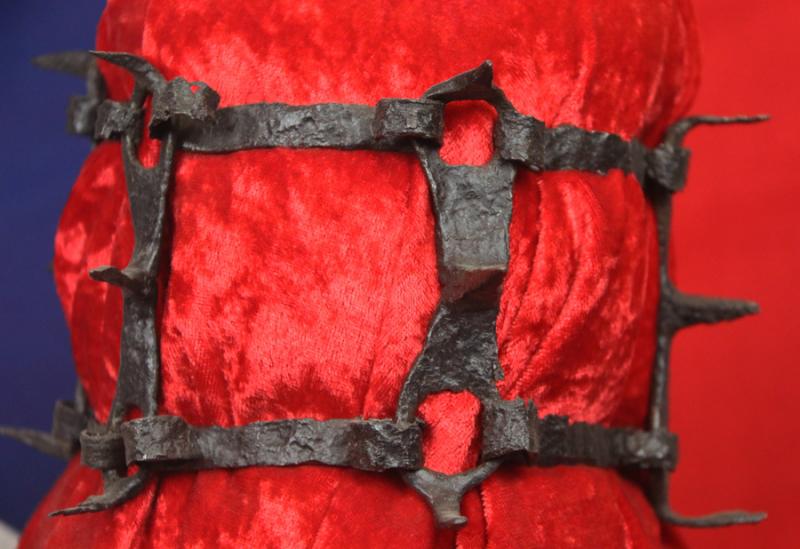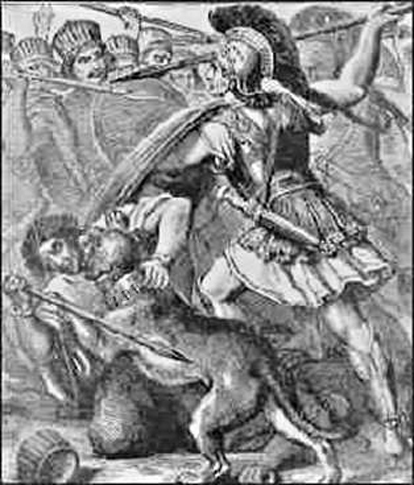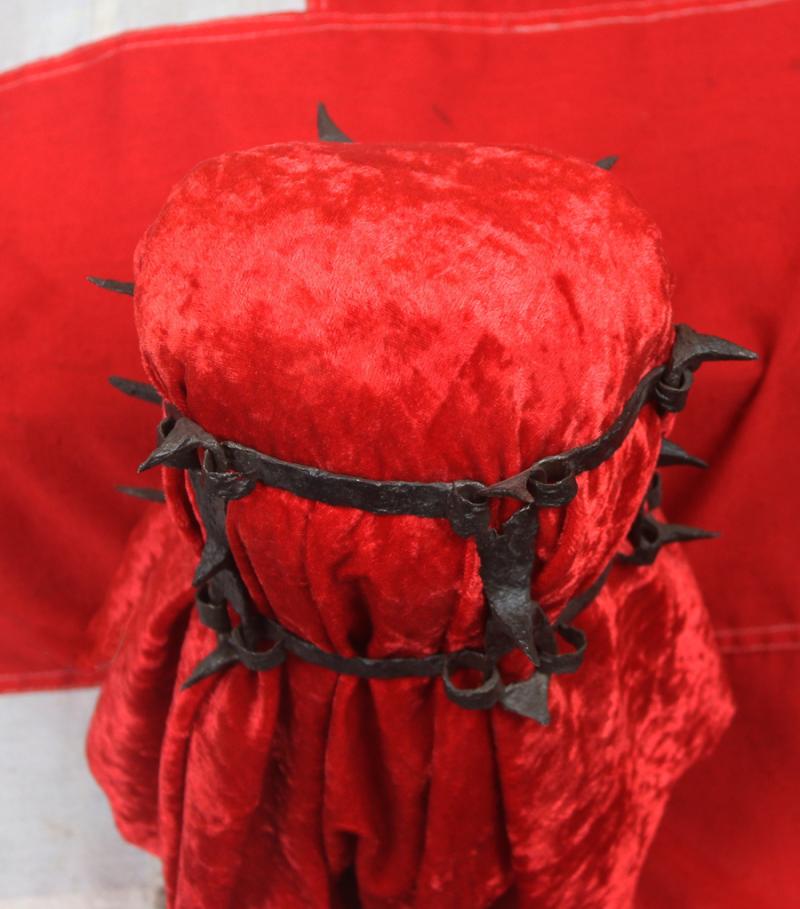An Incredibly Rare Piece Of Early 15th Century Canine Combat Armour. A Fabulous Agincourt Period 'War-Hound' Spiked Iron Collar.
This is the kind of ancient antiquity that one never normally sees outside of a grand museum collection, such as at the Tower of London or Nuremberg Castle.
It is an original piece of very rare 15th Century canine armour, from the period of King Henry Vth, and the Battle of Agincourt era. In smith forged iron, with it's multiple rows of spikes within a frame body, complete with it's circular neck shape form intact.
In battle the neck of the dog was most vulnerable from attack from such as an enemy’s sword, but once worn, this collar could defend the hound from many strikes and blows of a blade, plus, if the hound could pin an attacker to the ground, the spikes would defeat any attempt to pull or push off the attack by gripping the hound around the neck, it’s only area of weakness.
The ever faithful ‘war hound’ has its fame and renown littered through history, both ancient and modern. Today they are used in many armies for numerous purposes, but in early history they were the faithful companion of the fortunate knight and his followers, going back millennia, to Ancient Rome, the Germanic Goths and the Ancient Britons Iceni.
The same type of war hound collar as was worn by the British knight, Sir Peirs de Leigh’s, faithful mastiff, that stood heroically above his master’s wounded body at the Battle of Agincourt. Defending his fallen master with his life for many hours against all the incoming attacking French knights and their yeomen on the bloody and desperate battlefield. Thanks to that hound’s tenacity, loyalty and devotion, most incredibly, both he and his master survived that most bloody of battles.
On 12 August 1415, Henry sailed for France, where his forces besieged the fortress at Harfleur, capturing it on 22 September. Afterwards, Henry decided to march with his army across the French countryside towards Calais despite the warnings of his council. On 25 October, on the plains near the village of Agincourt, a French army intercepted his route. Despite his men-at-arms being exhausted, outnumbered and malnourished, Henry led his men into battle, decisively defeating the French, who suffered severe losses. It is often argued that the French men-at-arms were bogged down in the muddy battlefield, soaked from the previous night of heavy rain, and that this hindered the French advance, allowing them to be sitting targets for the flanking English and Welsh archers. Most were simply hacked to death while completely stuck in the deep mud. Nevertheless, the victory is seen as Henry's greatest, ranking alongside the Battle of Crecy (1346) and the Battle of Poitiers (1356) as the greatest English victories of the Hundred Years' War.
Sir Piers Legh II (died 16 June 1422), also known as Sir Piers de Legh and Peers Legh, was the second generation of the Leghs who was wounded in the Battle of Agincourt. His Mastiff stood over him and protected him for many hours through the battle.
Amazingly that incredible faithful and brave hound returned safely to Legh's home in England with his master, to unbridled praise and local admiration. It was to become the foundation of the Legh Hall mastiffs. Five centuries later, this pedigree figured prominently in founding the modern English Mastiff breed and an old stained glass window remains in the drawing room of Legh Hall portraying Sir Piers and his devoted mastiff. He was injured again in action in 1422 and died as a result of his wounds in Paris. He was Buried at St Michael's church, Macclesfield in the Legh chapel, which had been built to receive his body.
Between years 1387-1388, in the ‘Hunting Book’, Gaston Fobus speaks about the amazing faithful war dogs “Alaunts are able to cross all other bloods, to which it cuts their ears to evenness to avoid to them be wounded in the fight”. In Spain the great war dog was the Alaunt or prey-dog, in Britain it was the similar Mastiff or Bull Mastiff. In the stories of the writers of the time, it was spoken of the Alaunts that the Spanish explorers took to cross the virgin forests of South America. There was some of these stories, in which they narrated an infinity of anecdotes with respect to intelligence, bravery and fidelity that owned the Alaunts.
In March 24, 1495, within the Antilles was the first battle of the native Indians, and commanded by the Caonabo Cacique was a battle with dogs. The brother of Cristobal, Bartolome Colon, employed 200 men, 20 horses and 20 Alaunts like Spanish forces. It was the ‘debut’ of the Alaunts in the American Conquest. Some Alaunts deserved, for their services, that one pays to them their fair due. Fernandez de Oviedo speaks of a Alaunt called “Becerrillo", which always accompanied the conqueror Diego de Salazar. One said that ten soldiers with “Becerrillo", were made more fearful than more than one hundred soldiers without the dog. For that reason it had its part in booties, and received it's pay like any soldier. War Dogs were trained to fight in combat either against man or beasts such as bulls. We show pictures in the gallery of famous war dogs from the time of Ancient Rome by Romans, by Ancient Britons, being used in Medieval England and in the US Civil War.
An informed instruction of the correct Mastiff hound to protect the household, written in 1586,
Barnabe Googe's
‘Mastie that keepeth the house’ - with large and mighty body - brown, grey eyes, blackish lips
“First the mastie that keepeth the house: for this purpose you must provide you such a one, as hath a large and a mightie body, a great and a shrill voice, that both with his barkng he may discover, and with his sight dismay the theefe, yea, being not seene, with the horror of his voice put him to flight; his stature must neither be long nor short, but well set, his head great, his eyes sharpe, and fiery, either browne or grey, his lippes blackish, neither turning up, nor hanging too much downe, his mouth black and wide, his neather jawe fat, and coming out of it on either side a fang, appearing more outward then his other teeth; his upper teeth even with his neather, not hanging too much over, sharpe, and hidden with his lippe. His countenance like a lion, his brest great and shaghayrd, his shoulders broad, his legges bigge, his tayle short, his feet very great; his disposition must neither be too gentle, nor too curst, that he neither fawne upon a theefe, nor flee upon his friends; very waking, no gadder abroad, not lavish of his mouth, barking without cause; neither maketh it any matter though he be not swift: for he is but to fight at home, and to give warning of the enemie.”
Mounted for display this would be one of the greatest curiosities and conversation pieces imaginable. Not only an amazing original heirloom of historic wonder from the days of armoured knights, but an artefact from one of the most fascinating periods of British history.
Code: 22321


